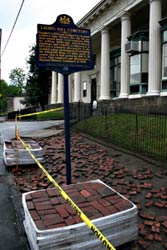This article is part of a series on How Historic Laurel Hill Cemetery Is Reinventing Itself. It is based on an interview with Ross Mitchell, Executive Director of Laurel Hill Cemetery in Philadelphia, PA.
Stoneangels: I saw you on the PBS documentary, “A Cemetery Special” a few months ago. Is there a documentary on Laurel Hill available?
Ross Mitchell: No, but WHYY’s Arts & Culture Service presents stories about interesting destinations across the Delaware Valley, all the historic attractions and landmarks, like Laurel Hill, the Wharton Eshrick Museum. That short documentary was what you saw. We have a gentleman who has a company that does a lot of corporate promotional pieces and he has gotten the bug for Laurel Hill! He’s already done a promo piece for us and he’s trying to find the funding–we need two or three hundred thousand dollars to do a decent documentary. He wants to get some re-enactors and he’s got a whole grand vision. We’d love to get that done but we have so many funding needs.
Stoneangels: I can see why you want to draw people here for the great cultural benefits, but how does that provide income to keep the cemetery going?
Ross Mitchell: We have the Friends of Laurel Hill, a non-profit 501(c)(3) support group for the cemetery. Laurel Hill is a 501(c)(13) Non-Profit, which is solely for cemeteries–the cemetery does a civic good (takes care of the dead), if this property wasn’t tax exempt it would be taxed out of business. But it’s not a non-profit where you can give a donation and take a tax deduction. So the Friends was formed in 1976 as the non-profit support group that can raise money, that can write grants, and to whom people can give tax deductible contributions. The Friends’ mission is: historic preservation and educational outreach and programming.
Stoneangels: And you’re also the director of the Friends?
Ross Mitchell: Yes. The cemetery has many individual endowments for lots (which only pay for the separate lot care) but the cemetery is not making money. The Friends are trying to get to a place where first of all we’re supporting ourselves and the approach we’re taking to do that is by making the cemetery into a destination location through educational outreach programming. And we write as many grants as we can. We need to make Laurel Hill known-we’re one of the best-known secrets in the city (laughs)!
Stoneangels: Here’s a naive question: Since Laurel Hill’s a National Historic Landmark; doesn’t that entitle you to some government funding?
Ross Mitchell: No one’s entitled to anything! You have to earn it through your programming, your grants, through your needs, and it depends on who you’re competing against! If there are twenty National Historic Landmarks competing for the same grant, some have to win, some have to lose. You have to make sure your needs are projected in the best light and you never know who you’re competing against! It’s a competition, like anything.
 Sidewalk replacement along Laurel Hill’s main Ridge Avenue gatehouse entrance.
Sidewalk replacement along Laurel Hill’s main Ridge Avenue gatehouse entrance.
Stoneangels: I knew they didn’t just hand you a check, because if you had all the money you needed, you’d right the tipped monuments, do some painting–
Ross Mitchell: Right, well there’s a fund-raising pyramid: at the bottom of the pyramid is your membership and in the middle are your grants; the top of the pyramid are your private donors, and they make up a huge percentage–more than 50%–of what the pyramid should be composed of. So even if you get all the grants in the world and all the membership in the world, that’s not enough to sustain organizations. So they really need a three-tiered approach. We’re trying to build up individual funding, public funding, our foundational funding, and expanding our membership and our educational outreach program.
We also have two strategic plans-we have a Historic Preservation strategic plan and an Interpretive Programming strategic plan. The plans outline how we want to move ahead. The Interpretive Programming plan gives us a structure for our tours and our outreach into the community.
Next: Yellow Fever Business: Why Laurel Hill’s Popularity Soared in the 1800